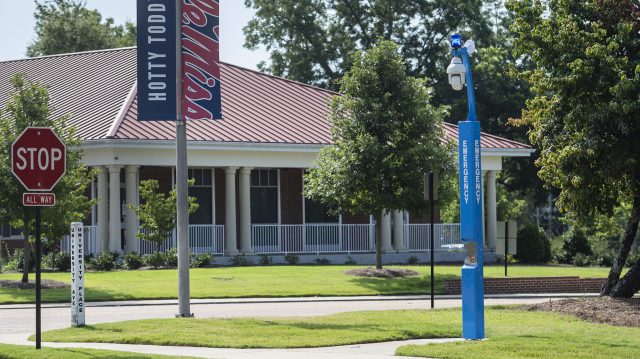
New and improved blue light emergency stations have been installed around the University of Mississippi campus. The devices include a high-resolution camera that relays real-time video from the location to the University Police Department. Photo by Logan Kirkland/Ole Miss Digital Imaging Services
OXFORD, Miss. – In an effort to provide an even more safe and welcoming campus, the University of Mississippi is updating its blue light station emergency response system, adding an additional layer of security for students, faculty, staff and visitors.
The university has begun replacing the aging blue light stations across campus. If in danger, students, faculty, staff and visitors can press a button on a station, which immediately starts a blue strobe light, dials the University Police Department dispatcher and activates a pan-tilt-zoom camera, providing high-resolution video from the site. The dispatcher can then relay information to a responding officer.
In response to student requests to update the stations, Chancellor Glenn Boyce has been instrumental in overhauling the system to provide an even safer environment for everyone.
“This was a student-led issue, and I am proud that we were able to partner to make Ole Miss even stronger,” Boyce said. “I also want to thank the hard-working staff members across campus who conducted the necessary research and installation for their time and commitment.
“Ole Miss has always been a safe home for the members of our university family, but these new blue lights will add an extra layer of comfort and safety for our students.”
Eighteen of the units will be a pedestal-style stations designed for high visibility, six are wall-mounted inside the RH2 and RH3 residential buildings and 14 are located near the elevators on all floors of the north parking garage. The stations provide a direct link to that particular area of campus for the department should an emergency arise, UPD Chief Ray Hawkins said.
“They give our community comfort in knowing they can get a law enforcement response at the push of a button,” he said. “The new towers have cameras, so not only are we able to hear, but now we can see the caller and monitor activities until officers arrive.
“The new improved emergency phone towers, like many of the crime prevention services and community engage opportunities we provide, are essential to keeping our community safe.”
Associate Student Body leaders advocated for the improvement and restoration of the stations around campus.
“As a university that prides itself on its safety, the fact that there were so many stations down created an aura of danger by the simple nature of us constantly seeing ‘Out of Order’ as we walked around campus,” ASB President Joshua Mannery said. “Our senators, led by Charlotte Shackelford, especially deserve a huge amount of credit for pushing Chancellor Boyce almost immediately after he began his role to move the project forward and make it happen.”
Though the COVID-19 pandemic delayed work on the project, good progress is being made.
“Our goal is to have all units fully functional by the time students return to campus for the fall semester,” said John Supple, assistant director of telecommunications and project manager. “Hopefully, we will never need to use any of them, but at least they will be available should an emergency situation arise.”
The university’s original blue light stations were installed more than 25 years ago with funds from a grant to UPD. The grant covered installation costs but was not enough for maintenance and repair.
“Over the years, Telecommunications, UPD and other offices have shared the costs of upkeeping the system’s units,” said Michele Patton, UM telecommunications director. “As existing buildings were either renovated or expanded and new buildings were built, the newer versions of blue light stations were installed.
“The new technology meant that the old either had to be upgraded or replaced. The university decided to go with the latter.”
The university has a plan to fully check the devices monthly for functionality and will repair as problems arise, Supple said.